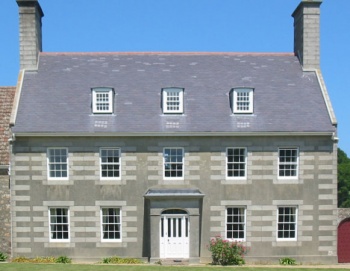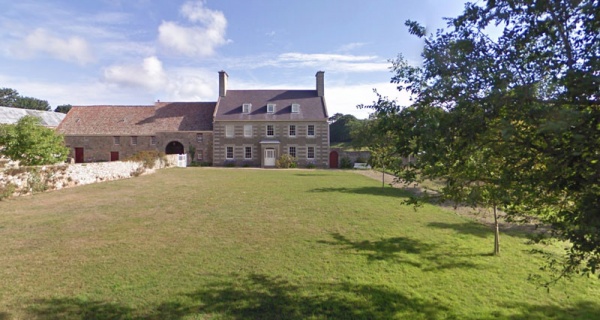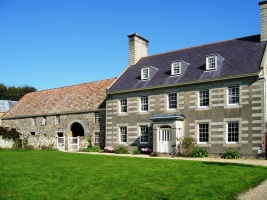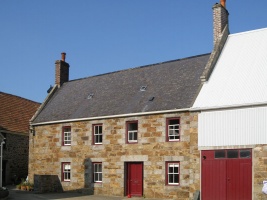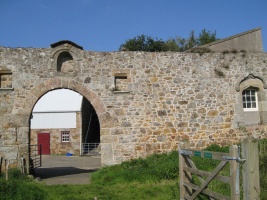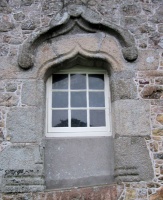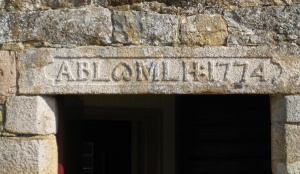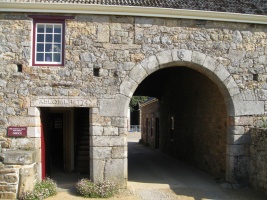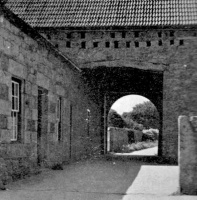Property name
The Elms
Previous names
Les Ormes
Location
Cheve Rue, St Mary
Type of property
Bequethed under the will of Nicolle John Perree in 1975, The Elms has been the Headquarters of the National Trust for Jersey since 1978. It has been the site of an important house for many centuries, with the oldest architectural remains dating from the 16th century.
The Elms comprises the main dwelling house, a subsidiary farmhouse, a dower house, an extensive range of outbuildings, including a boulangerie and a pressoir, a walled garden, orchard and approximately 80 vergees of land.
Behind the early 20th-century cement render of the main house lies an imposing and substantial Georgian house dating from around 1740. The five-bay double-pile house was constructed in the English Georgian style with high quality punch dressed aslar stonework for the principal elevation, complemented by large elegant sash windows and a fine graduated slate roof. Surmounting the roof, but sadly lost, was once a belvedere or cupola allowing the owners extensive views of the valley and their lands.
The offices and council room have been sensitively constructed within the former apple store and latterly potato store of The Elms pressoir. Great care has been taken to provide a modern office environment without comprising the historic fabric and architectural integrity of the building. All the works are fully reversible with the majority of the construction and joinery work completed by Trust staff.
Below the offices are the apple-crusher and press, providing a unique insight in to an industry which once played a dominant role in Jersey’s agricultural landscape.
The Walled Garden was constructed in the mid 18th century as indicated by one of the granite stones near the main entrance. With the help of volunteers, the garden is used for the production of local trees, wild flower seeds, and a range of fruit and vegetables.
The Trust, together with the Jersey Cider Orchard Trust, established a new cider orchard at the Elms in November 2003. The 109 trees are made up of over 20 traditional Jersey cider apple varieties.
The meadows and orchard are beautiful spots for picnics and during office hours access is also permitted to the office, pressoir, farmyard and boulangerie. The main house and farmhouse are tenanted and unavailable for viewing. Limited on-site parking is available.
Families associated with the property
Datestones
- ABL♥MLH 1774 [1] - for Amice Balleine and Marie Le Hardy, who married at St Saviour on 25 October 1760 [2]
- IIN 1734 - for Jean Journeaux. Between the initials and the date is an engraved prawn, from the Journeaux coat of arms
Historic Environment Record entry
Listed building
An important, high quality example of 18th century house and associated 18th/19th century farm group, with elements dating back to the 15th century.
The site includes an important and apparently unusually extensive (for Jersey) early 18th century garden layout for a lesser manor house, which survives in part in relict form. The notable features include the ornamental use of a re-set elaborate arch as a feature on the approach, a formal raised garden terrace with a (now lost) water garden below, and a sophisticated walled garden which survives in good condition. These features are typical of minor layouts of the period in the UK but are unusual in their combination with an unusual early 19th century flood-meadow system. The site is of considerable significance in Jersey, where it seems that very few extensive gardens were constructed in this period or survive.
The property has medieval origins. Early architectural features are incorporated into the later structures and it is believed that the chapel of St Symeon was located here - the fields to the east being named Les Monts Simon.
The house was the manor house of the Fief du Câtelet in St John from before 1500 until the 19th century, as its owners were then seigneurs of that Fief. The name 'The Elms' was given to the property by Captain Jean Perree, who purchased the house in 1816 and planted elm trees on either side of the roadway. The property was gifted to the Trust by Nicolle Jean Perree in 1975.
The principal building is 18th century - academic studies concluding that the house was either built in the 1730-40s or in the 1770s.
The dower wing is earlier, being late 17th century, built above and next to a 15th century stone arch, which is believed to have been originally part of a free-standing wall carried across to join the old house. The medieval arch has an armorial keystone showing a cross and a rose, and exceptional chamfer-stops decorations with tower motifs. There was originally an upper row of voussoirs, one stone of which survives above the right shoulder stone.
There are two rows of nesting holes for pigeons above the archway on the farmyard side, indicating the high status of the house at that time. In the late 17th century, the range of buildings extending west was added and a floor was built above the arch.
To the left of the doorway is a mounting block incorporating a decorated window lintel and what appears to be the base of a wayside cross. There are the remains of a late 17th century external stone staircase leading to first floor accommodation, and a roughly hewn joist of great length supports the floor above over the passageway linking the two sides.
The adjacent farm group developed in several stages during the 18th and 19th centuries. The oldest appears to be the bakehouse - originally a one-roomed cottage - which has a fireplace canopy lintel made from a reused early 17th century octagonal stone porch pillar, and a carved wall seat.
The granite wall that runs along the east side of the farm group incorporates various interesting features (most believed to have come from the medieval chapel of St Symeon, formerly on site): a datestone lintel above the Journeaux doorway; two decorated window lintels and a 16th century round arch niche with attached cable-moulded shafts (possibly a benitier) around the side entrance arch; and a small 15th century ogival doorway with a fleur-de-lys finial built into the wall to the north of the arch.
The occurrence of so many decorative features in this wall suggests that it was the backdrop to an 18th century garden of some importance.
The early 19th century flood-meadow system has a stone lined stream and irrigation channels, which were laid out by troops stationed at Greve de Lecq Barracks and hired by Captain Jean Perree.
The house retains its 18th century layout with a spacious main hall and first floor landing - the absence of a traditional cabinet bedroom over the front hall being a rarity. The interior has many fine features - of particular interest being the mid-18th century marble square paving in the hall, of typical English pattern with grey and white squares laid diagonally in a chequerboard pattern, and an early 18th century staircase with elm treads and risers, with mahogany handrail and trim.
The kitchen has 19th century full height painted dressers with timber cornices, a granite fireplace with quadrant shaped corbels, and the remains of a dog-operated spit.
Also of note is the stone engraving in the shape of cross by the fireplace in the office, and late 18th century painted wall panelling, including fireplace surrounds, in three bedrooms on the first floor. On the second floor, middle bedroom, the north wall is covered with newspaper over which a montage of plates from magazines was pasted - dates starting at 1858.
Old Jersey Houses
The property has a substantial entry in Volume 1 of Joan Stevens' Old Jersey Houses. This is an abridged version giving the highlights.
The apparently ecclesiastical remains built into the walls of this farmyard have been the subject of many differing opinions, and it is not possible to be sure from whence they come.[3]
The present dwelling house is not very old and may have been built at the time of the 1774 stone. Previously the property had belonged to the Journeaux family, who also owned Gigoulande Mill nearby.
In 1674 Philippe Balleine married Elizabeth Journeaux and their son Pierre settled in St Mary in 1735, in his uncle's house, which was this one, then called Les Ormes. Jean, the son of Amice Balleine and Marie Le Hardy, sold the house to Jean Arthur in 1810, and he sold it to Jean Perree in 1816, and it still belongs to his descendants, though not in the direct line.[4] [5]
Notes and references
- ↑ The heart symbol is upside down. This stone is inexplicably mentioned twice in Old Jersey Houses as having the date 1773
- ↑ Marie died in 1779, after having nine children, and Amice married for a second time the following year to Marie Le Geyt. Both marriages were in St Saviour
- ↑ Half the article on The Elms is devoted to supposition about this being the possible site of an ancient chapel, but no conclusions are drawn.
- ↑ It is not clear what the writer meant by 'not in the direct line'. Descendants, by their very nature, are in the direct line of their ancestors. The book was published before the property was given to the National Trust for Jersey by the Perree family
- ↑ The remainder of the article is devoted to discussion of architectural features and further speculation about their origins
